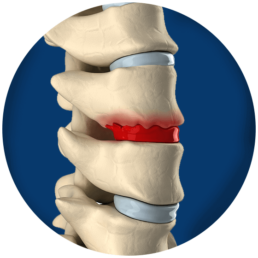Bone Spurs

Bone Spur Symptoms & Treatment Options
Bone spurs are bony growths that develop in response to inflammation caused by bone degeneration. Found widely in middle-to-older-aged adults, bone spurs occur in and around the joints of the body.
As the body ages, a normal degree of wear and tear occurs. Not surprisingly, this wear and tear appears near places of high movement and friction… Like the joints! Degeneration in the form of cartilage breakdown can lead to joint instability and subsequent inflammation from bone-on-bone contact. In an attempt to stabilize and fortify the damaged joint, the body reacts by growing more bone in the place of lost cartilage.
These new bony growths, although developed with good intentions, are often what turns into painful bone spurs. And although major joints are prime locations for the sprouting of bone spurs, one of the most common sites for bone spur growth arises in the spine.
The spine is comprised of over 30 main vertebrae attached to each other in over 30 different joints. This abundance of joints, plus their constant motion, makes the spine a major player in the world of bone spurs. Even further, the spine is chock-full of small spaces for degeneration to occur and bone spurs to grow. What naturally lives in these small spaces? The crucial spinal nerves that fall victim to encroaching bone spurs. This leads to a whole host of uncomfortable and troubling symptoms.
If you or someone you know is experiencing bone spurs, some of the most common symptoms include:
Localized pain at the location of the bone spur as a result of pinched nerves
Burning or tingling sensation in the back or radiating to the hands and feet
A minor pain in the neck or lower back when standing, walking, or laying down
Loss of mobility or stiffness in the back, possibly radiating into arms and legs
Muscle spasms, cramps, weakness, or tightening due to nerve compression and damage
Radiating pain can occur, striking down the arms or legs depending on the bone spur location
Symptoms of Bone Spurs
The symptoms of spinal bone spurs can vary from person to person, and from location to location in the spine. For many, spinal bone spurs will create a legion of physical and sometimes neurological symptoms.
For some, bone spurs may go completely unnoticed. For others, spurs can cause excruciating pain as they press on adjacent spinal nerves. If you are experiencing the latter, you are most likely on the hunt for relief. And, our team of spine specialists at The Advanced Spine Center of NJ is ready to help you find it. Our experienced and knowledgeable team of clinicians have earned years of experience in diagnosing and treating a variety of complex spinal conditions. They will work one-on-one with you to pinpoint any contributing factors and nip them in the bud.
Causes of Bone Spurs
There are a few reasons that bone spurs may arise in the spine. Of course, most of these are all related to inflammation and joint degeneration. However, the root of this degeneration can vary. Here are just a few causes of bone spur development:
Age: Most cases of bone spur development can fall into this main category. The aging process leads to a whole host of conditions and circumstances that promote bone spur growth. Degenerative Disc Disease is one of these main conditions. Through normal wear and tear, the intervertebral discs dry out, thin, and break. This causes compression in the spine, and the vertebrae can find themselves stacking closer together. Vertebrae begin to rub directly on one another. And without their cushioning intervertebral disc companions to buffer, irritation and inflammation can ensue. Nerves become pinched, pain follows, and bone spurs develop to try to counteract all of this.
Injury: Injury is another common source of bone spur growth. Trauma to the spine can lead to damage to the bone and inflammation. If the injury does not heal, or has trouble healing, these damaged bones can start to develop bone spurs to try to alleviate the problem. Especially when a break or fracture is involved, the bones will always want to grow to promote stability. If this growth happens anywhere near a nerve, painful trouble can ensue.
Osteoarthritis: Osteoarthritis is a condition that causes accelerated degeneration of the cartilage between joints. That right there tells us it creates the prime environment for bone spurs. Needless to say, individuals with Osteoarthritis also tend to develop many bone spurs.